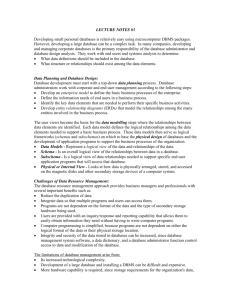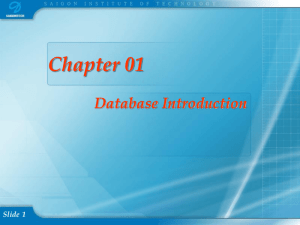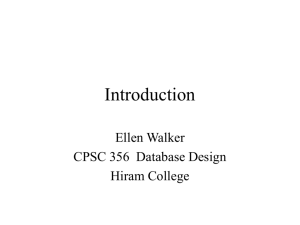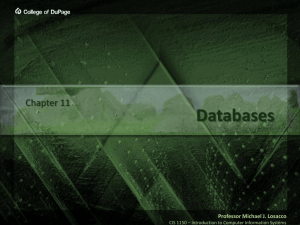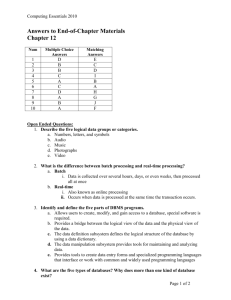Database
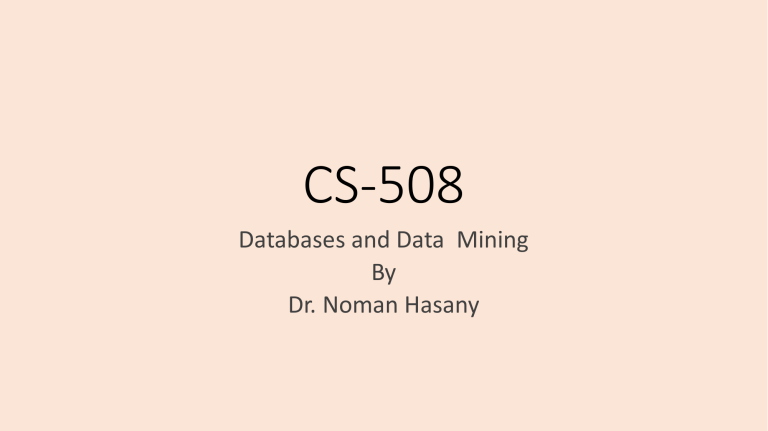
CS-508
Databases and Data Mining
By
Dr. Noman Hasany
Course Contents
-Components and Functions of a DBMS
-Query processing and optimization
-Concurrency control
-Security
-Recovery
-Integrity in DBMSs
-Distributed databases
-Study of intelligent database systems
-Study of different object-oriented data models
-Introduction to XML technologies
-Project: Development of a database application.
Text Book and Reference Material
Textbook
Connolly, T. C. Begg, “Database Systems : A Practical Approach to
Designing, Implementation and Management”. 4 th ed
Further Reading
Witten I. H., F. Eibe, “Data Mining: Practical Machine Learning Tools and Techniques”, 2nd Ed., Morgan Kaufmann Series in Data Management
Systems, 2005.
Project resources
http://www.cs.nott.ac.uk/~psznza/G51DBS08/
www.sqlcourse2.com/
www.w3schools.com
Chaps QBE
Sessional Marks
Sessional : 60
Midterm-1 : 20 Marks
Midterm-2 : 20 Marks
Homework : 10 Marks
Project : 10 Marks
Final Exam : 40
Part -1
Introduction to Databases
What is a Database?
“A set of information held in a computer”
Oxford English Dictionary
“One or more large structured sets of persistent data, usually associated with software to update and query the data”
Free On-Line Dictionary of Computing
“A collection of data arranged for ease and speed of search and retrieval”
Dictionary.com
Databases needed for…
Web indexes
Library catalogues
Medical records
Bank accounts
Stock control
Personnel systems
Product catalogues
Telephone directories
Train timetables
Airline bookings
Credit card details
Student records
Customer histories
Stock market prices
Discussion boards
and so on…
File-Based Approach
A collection of application programs that perform services for the
system end-users such as the production of reports. Each program defines and manages its own data.
Developed in response to the needs of industry for more efficient data access.
DreamHome Example
The Sales Department is responsible for the selling and renting of properties.
For example, whenever a client/owner approaches the Sales
Department to market his/her property for rent, a form is completed, as shown in Figure 1.1(a).
The Sales Department also handles inquiries from clients, by forms shown in Figure 1.1(b) completed for each one.
With the assistance of the Data Processing Department, the Sales
Department creates an information system to handle the renting of property. The system consists of three files as illustrated in Figure 1.2.
DreamHome Example
Whenever a client agrees to rent a property, a form is filled in by the
Sales staff containing client and property details, as in Figure 1.3. This form is passed to the Contracts Department which allocates a lease number and completes the payment and rental period details.
The system consists of three files storing lease, property, and client details, containing similar data to that held by the Sales Department, as illustrated in Figure 1.4.
Figure 1.5 shows that each department accesses their own files through application programs written specially for them.
File based systems
Data is stored in files; each file has a specific format; programs that use these files depend on knowledge about that format.
Major problem
Separation and isolation of data
When data is isolated in separate files, it is more difficult to access data that should be available. For example, producing a list of all houses that match the requirements of clients, we first need to create a temporary file of those clients with preferred type as ‘house’. We then search the PropertyForRent file for property type ‘house’ and the rent is less than the client’s maximum rent. With file systems, such processing is difficult. The application developer must synchronize the processing of two files to ensure the correct data is extracted.
This difficulty is compounded if we require data from more than two files.
File based systems
Other problems:
No standards -> incompatible file formats
Data duplication
Data dependence (e.g. increasing the size of the PropertyForRent address field from 40 to 41 characters, needs all programs accessing this file to be changed)
Fixed queries, no way to generate ad hoc (prompt) queries
No provision for security, recovery, concurrency, etc.
Database Approach
All the above limitations of the file-based approach can be attributed to two factors:
(1) the definition of the data is embedded in the application programs, rather than being stored separately and independently;
(2) there is no control over the access and manipulation of data beyond that imposed by the application programs.
The Database
Database: A shared collection of logically related data, and a description of this data, designed to meet the information needs of an organization.
A self-describing collection of integrated records; known as the
system catalog (or data dictionary or metadata – the ‘data about data’). It provides program–data independence.
The internal definition of an object can be changed without affecting the users of the object, provided the external definition remains the same.
The Database
A database is ‘logically related’ in terms of entities, attributes, and relationships.
An entity is a distinct object (a person, place, thing, concept, or event) in the organization that is to be represented in the database.
An attribute is a property that describes some aspect of the object that we wish to record, and
A relationship is an association between entities.
Entity–Relationship (ER) diagram for part of the DreamHome case study. It consists of: six entities: Branch, Staff, PropertyForRent, Client, PrivateOwner, and Lease; seven relationships : Has, Offers, Oversees, Views, Owns,LeasedBy, and Holds; six attributes, one for each entity: branchNo, staffNo, propertyNo, clientNo, ownerNo, and leaseNo.
The Database Management System (DBMS)
A software system that enables users to define, create, maintain, and control access to the database.
It provides controlled access to the database. For example, it may provide:
a security system, which prevents unauthorized users accessing the database;
an integrity system, which maintains the consistency of stored data;
a concurrency control system, which allows shared access of the database;
a recovery control system, which restores the database to a previous consistent state following a hardware or software failure;
a user-accessible catalog, which contains descriptions of the data in the database.
(Database) Application Programs
A computer program that interacts with the database by issuing an appropriate request (typically an SQL statement) to the DBMS.
Views reduce the complexity by letting users see the data in the way they want to see it.
Views provide a level of security.
Views provide a mechanism to customize the appearance of the database.
A view can present a consistent, unchanging picture of the structure of the
database (If fields are added or removed from a file, and these fields are not required by the view, the view is not affected. Thus, a view helps provide the program–data independence)
Advantages and Disadvantages of DBMSs
Databases Advantages
Control of data redundancy
Eliminate the redundancy by integrating the files so that multiple copies of the same data are not stored. But, sometimes, it is necessary to duplicate key data items to model relationships. At other times, it is desirable to duplicate some data items to improve performance but overall redundancy may be less than file systems.
Data consistency
If a data item is stored only once, any update to its value is available immediately to all users.
Databases Advantages
More information from the same amount of data
With the integration of the operational data, the Contracts Department has access to owner details and the Sales Department has access to lease details; which is contrary to the file based implementations.
Sharing of data
Database belongs to the entire organization and can be shared by all authorized users. New applications can build on the existing data or easily add new data, no need to define all data requirements again.
Improved data integrity
Constraints may apply to data items within a single record or they may apply to relationships between records. For example, branch number contained in a staff record, where the member of staff works, must correspond to an existing branch office.
Databases Advantages
Improved security
Without suitable security measures, integration makes the data more vulnerable than file-based systems. Restrictions can be defined on the data or on the operation one performs.
Enforcement of standards
DBA to define and enforce the necessary standards to facilitate exchange of data between systems
Economy of scale
Combining all the organization’s operational data into one database, and creating a set of applications that work on this one source of data, implemented as client-server.
Databases Advantages
Balance of conflicting requirements
Each user or department has needs that may be in conflict with the needs of other users. Since the database is under the control of the DBA, the DBA can make decisions about the design and operational use of the database.
Improved data accessibility and responsiveness
Query languages or report writers that allow users to ask ad hoc questions and to obtain the required information almost immediately at their terminal, without requiring a programmer to write some software.
Increased productivity
Low-level file-handling routines along with other typical functions are provided by DBMS, allows the programmer to concentrate on the specific functionality
Databases Advantages
Improved maintenance through data independence
a DBMS separates the data descriptions from the applications, thereby making applications immune to changes in the data descriptions, known as
data independence.
Increased concurrency
Many DBMSs manage concurrent database access and ensure such problems cannot occur. We discuss concurrency control (ch:20)
Improved backup and recovery services
Like nightly backup routine, roll back features etc.
Databases Disadvantages
Databases Disadvantages
Complexity
Complex piece of software, failure to understand which can lead to bad design decisions and can have serious consequences for an organization.
Size
Occupy many megabytes of disk space and require substantial amounts of memory to run efficiently.
Cost of DBMSs
Single user to multiuser DBMS software cost may vary from $100 to $100,000; plus annual maintenance cost.
Databases Disadvantages
Additional hardware costs
Disk storage requirements may necessitate the purchase of additional storage.
Performance may require purchase of a larger machine, perhaps dedicated to run the DBMS.
Cost of conversion ( from legacy to database )
cost of training staff to use these new systems, and possibly the employment of specialist staff
Performance
a file-based system is for a specific application however, the DBMS is written to be more general
Higher impact of a failure
The centralization of resources increases the vulnerability/weakness of the system.


